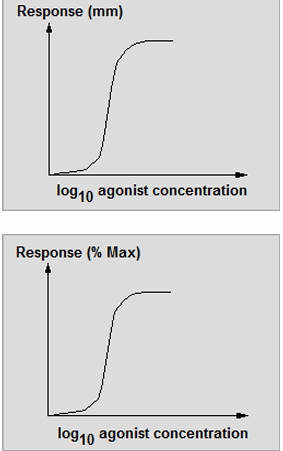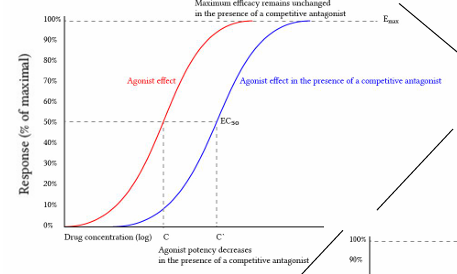Dose response curves
1/9
There's no tags or description
Looks like no tags are added yet.
Name | Mastery | Learn | Test | Matching | Spaced |
|---|
No study sessions yet.
10 Terms
agonist
drug that interacts with receptors. the resulting drug receptor complex geerates a response
receptor agonists
the size of response varies with the proportion of receptors occupied by the agonist varies with the concentration of the agonist
dose response curves intro
occupancy varies with the agonist concentration. It is difficult experimentally to measure how occupancy varies with the agonist concentration therefore it is more usual to measure the biological response. The results of such experiments are plotted on dose response curves
dose response curve
shows response against log10 agonist. sometimes, rather than showing the actual response, the response is plotted as a percentage of the maximum response possible. The graphs are very similar but the second graph shows the ratios rather than absolute values. This means that comparisons can be made between experiments

full agonists
agonists that elicit the maximum response are known as full agonists. Agonists which cannot produce the maximal response are known as partial agonist.
some agonists can produce maximal and others cant because of the characteristics of the tissue involved (total receptors and nature of receptors and response coupling) and the agonist receptor complex itself (intrinsic efficacy and is a property of the drug receptor complex
hyperbolic vs sigmoidal dose response curves
all 3 drugs receive same max, but at different concentration. red line reaches plateau earlier.

affinity and efficacy
as affinity decreases, the dose response curve shifts further to the right along the x axis. as efficacy increases, the maximum response that the agonist can produce also increases
spare receptor hypothesis
maximum response is achieved at less than full occupancy.
To generate a full response, it is not always necessary for all receptors to be occupied: only a fraction of the total number of the receptors needs to be occupied: only a fraction of the total number of the receptors needs to be occupies
more receptors are present than are needed to generate the full response: this leads to the idea of spare receptors
competitive antagonist
interacts with the same receptors as the agonist: the agonist ad antagonist therefore compete for the same receptors.
reversible competitive antagonist - effects can thus be reduced by adding more agonist. antagonist dissociates from the receptor
irreversible competitive analysis - increasing the agonist concentration has no effect. antagonist does not not dissociate from the receptor

non- competitive antagonist
affects the action of an agonist by acting at some point in the chain leading to the response e.g. blocking ion channels. it does not compete for the agonist receptors themselves
